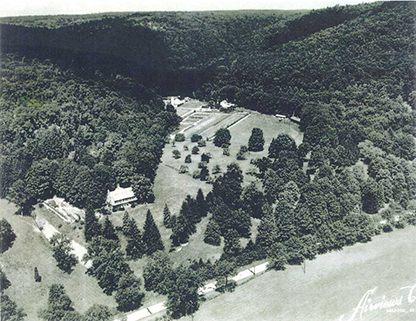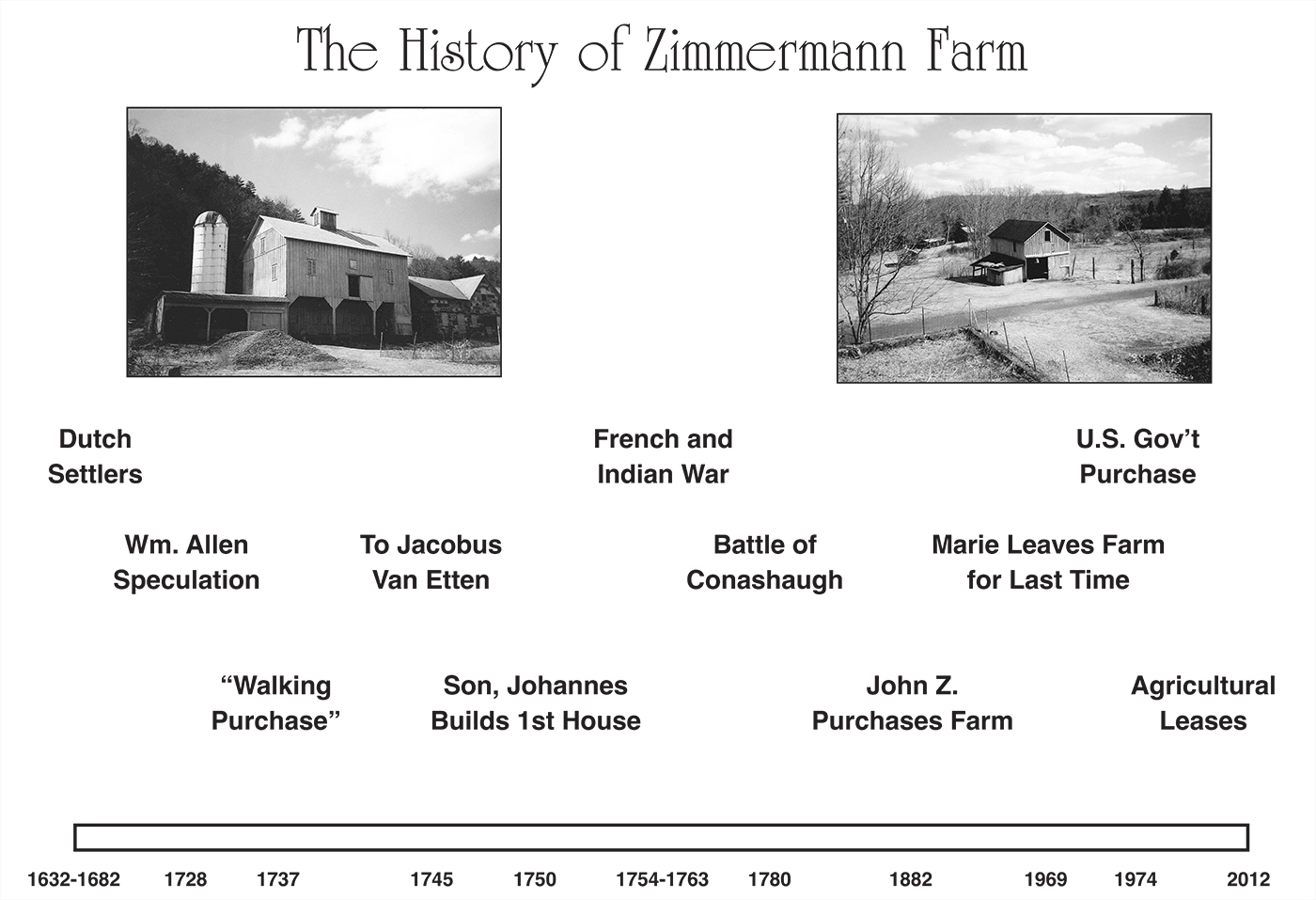
The History of Zimmermann Farm
The timeline from the first Dutch settlers in the Middle Delaware in the 1600s through the dramatic episodes of the beginning of the new American nation in the 1700s, to the relatively placid agricultural period of the 1800s and 1900s, to today's protection within the Delaware Water Gap National Recreation area (National Park Service), the Zimmerman Farm represents a colorful and contiguous story for generations to appreciate.
Most sources use 1682 as the first signs of the Dutch farming along this part of the Delaware. It was part of an early migration from Kingston, NY, along a natural valley to mine copper near the Delaware Water Gap. Bob Longcore, a founder of Friends and a past president of the Sussex County (NJ) Historical Society, and a very careful historian of the region, believed the date went back another 50 years.
Wm. Allen, a Philadelphia speculator, was the first to claim land that incuded Zimmermann farm in 1728 (evetually the Zimmermann's came to own 1200 acres). Shortly thereafter in 1737, the infamous "Walking Purchase" tricked the Indians into giving up all claim to a wide area of northeastern Pennsylvania. William Penn's sons had made a pact with the tribes that the Europeans could claim the land within a day's walk west from the river; the dirty trick was that the Penn's representatives ran. In 1745, Allen, now outright owner of the land, sells a parcel to Jacobus Van Etten for a farm. His son, Johannes, builds a house here in 1750. This was during what Bob Longcore called the 'contact period', in which the settlers and Indians lived peaceably together. He believed that this peaceful 'time' was significant to both sides and should someday be honored.
However, the peace was followed by the bitter 10-year French and Indian War with hostage-taking, scalpings, and homestead destruction. How Johannes and his family fared in all this, we don't know. Then in 1780, a bloody skirmish with the Indians occurred at the north end of the property, later called the Battle of Conashaugh, and considered the last major battle of the American Revolution.
In 1882, we know John Zimmermann purchases the property from Daniel E. Van Etten, likely the grandson of Johannes, who has worked the farm for most of his natural life. Marie loves the property and learns much from it, as Jack does 50 years later during summer stays as a young teenager.
In 1957 Marie decides to cease crop production, and lets the fields go to hay. And then, 12 years later in 1969, at 90, and with rumors of government purchase, Marie leaves the farm for the last time. Today, the Park Service leases the six river-plateau fields to the "farmer", who comes down from Wayne County (PA) to reap many bushels of feed corn.
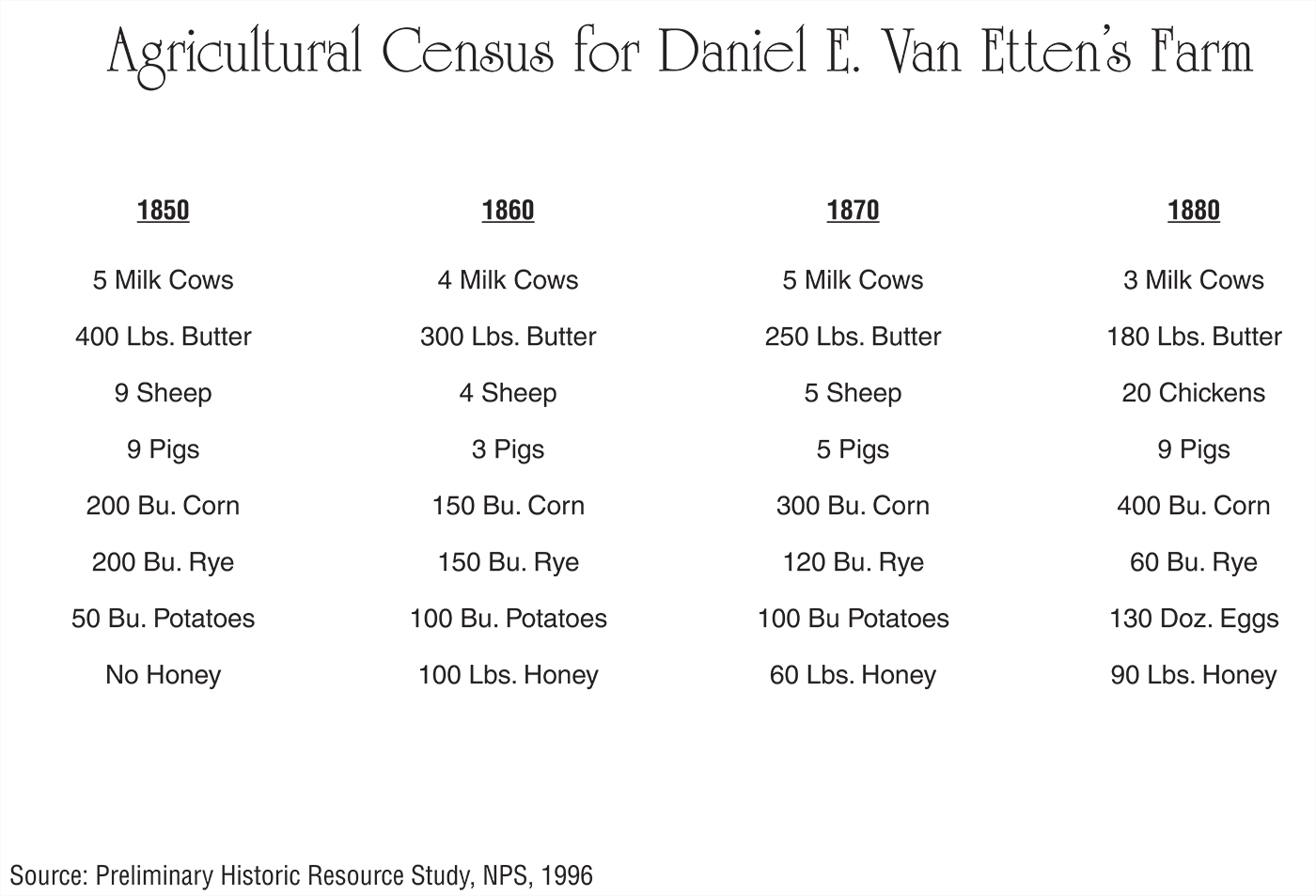
Agricultural Census for Daniel E. Van Etten's Farm
Looking at a snaphsot of mid 1800s farm production at Daniel Van Etten's farm, the agricultural censuses between 1850 and 1880 (we have this from the NPS' 1996 Preliminary Historic Resource Study of the Delaware Water Gap NRA), our imagination is stirred. Consider that the Van Etten's had no electricity, no mechanized transportation, and did most everything by hand.
Note that by 1880, corn has replaced rye as the main grain crop, and chicken raising for egg production has replaced sheep and potatoes.
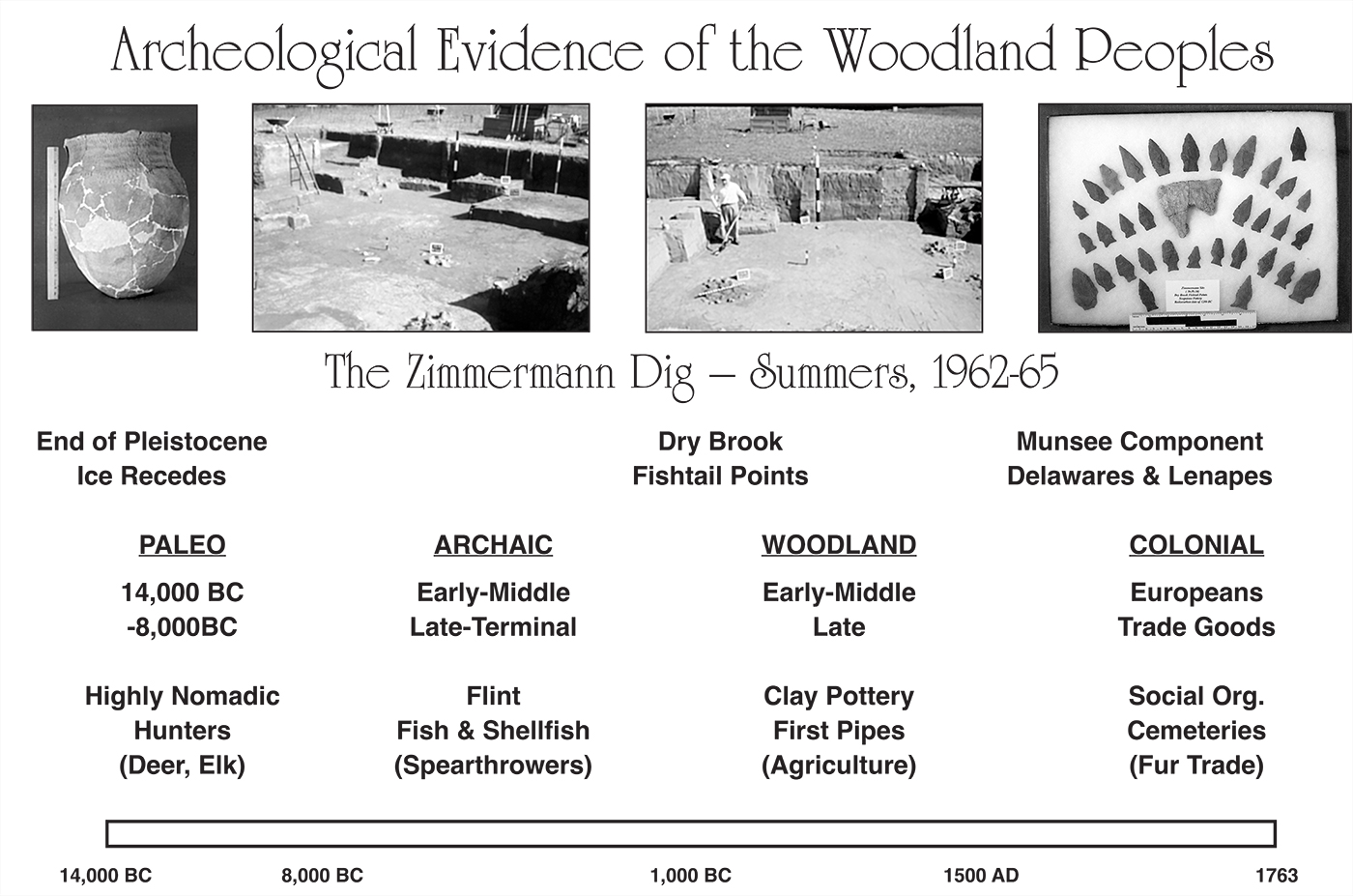
Archeological Evidence of the Woodland Peoples
A little known element of the Marie Zimmermann legacy is the archeological study (referred to as the Zimmermann Dig) she allowed on the lower terrace of the property near Dry Brook Creek in the 60's. It ties the property historically back another 3000 years from the time of the beginning of Dutch farming. The "Dig" came about because of the approaching Government purchase, which spurred archeological activity on both sides of the river. Working with volunteers, Archeologists uncovered and recorded hundreds of artifacts and midden (evidence of habitation).
The digging goes through four layers, or time periods, one of which is carbon dated to 1750 BC. All findings were recorded and later published under the Pennsylvania Historical and Museum Commission, Society for Pennsylvania Archeology, Lenape Chapter 12, The Zimmermann Site, David J. Werner, 1972.
The first layer represents the Colonial Period (1500 to 1763), when the Lenapes interacted with the Europeans peacefully for a time and then, goaded by the French, terrorized the settlers over a 10-year period (French and Indian War). The Woodland Period (1000 BC - 1500AD), comprising several layers, covered most of the material found at Zimmermann, with the oldest pieces carbon dated into the Archaic Period (1750BC).
The most significant finding in the Woodland Period is the definitive Dry Brook Fishtail Point, which establishes a unique time and artifact identity that can be juxtaposed to other archeological activity in the Northeast. Bill Leiser, a local citizen at the dig and a collector, tells us that the Fishtail time precedes similar findings on Long Island (NY) and after those found along the Susquehanna (PA).
All this interestingly points even farther back to the full Archaic Period (8000BC) and the Paleo Period (14,000BC), and the beginning of human habitation in this part of North America.
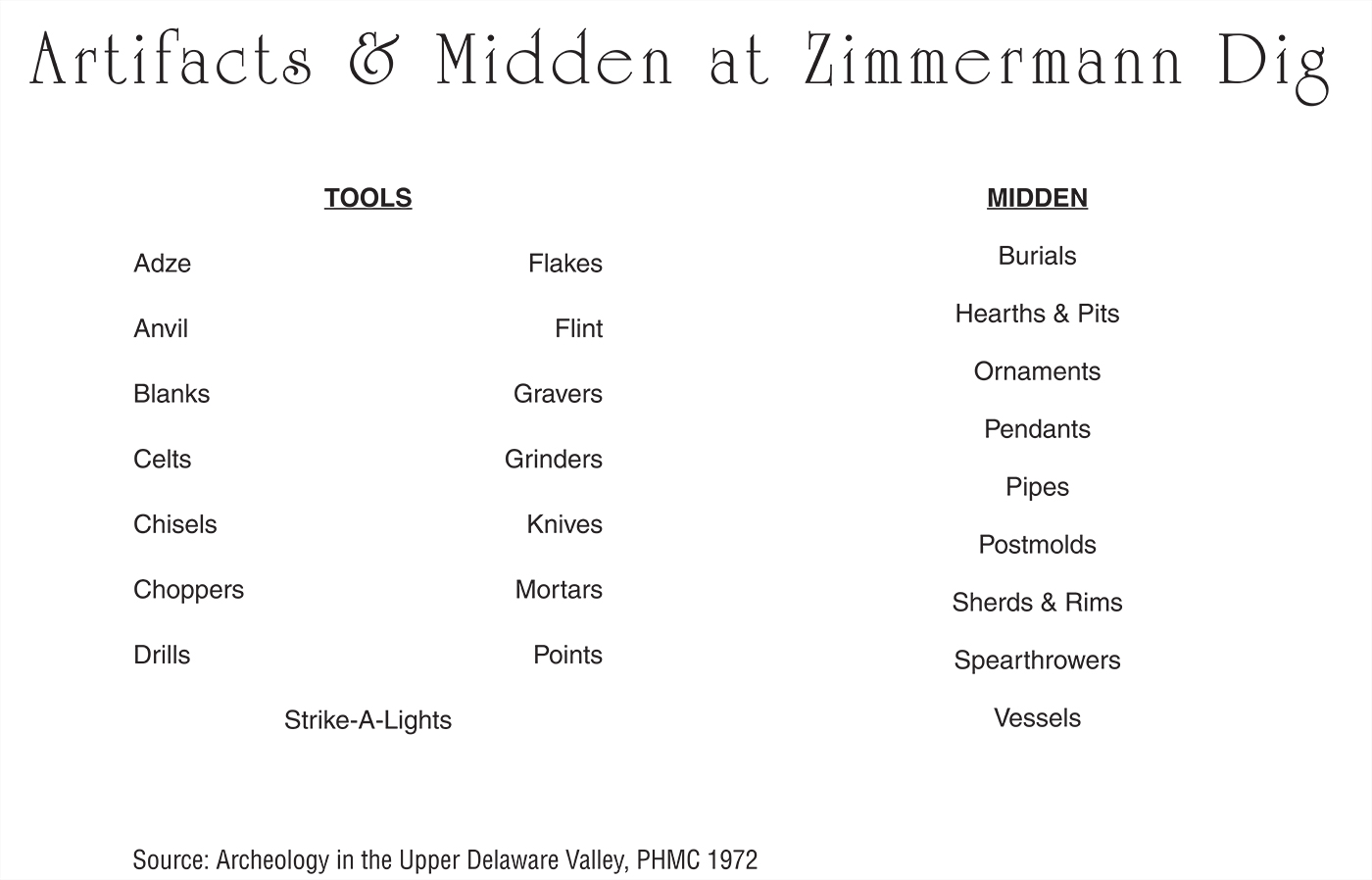
Artifacts and Midden at Zimmermann Dig
The lists, above, of types of artifacts and midden uncovered at the Zimmermann dig site in the 1960's portray the very basic tools and living patterns used in the woodland cultures for survival. The daily battle these peoples faced to sustain and protect themselves seem overwhelming to us.
Zimmermann Farm, then, represents a continuum of the entire range of human habitation in this part of the Delaware Valley. Once again, it is Marie who grants and encourages this mapping of human history.
Access to the archeology, if not available through the State of Pennsylvania, can be obtained by contacting the Friends of Marie Zimmermann.
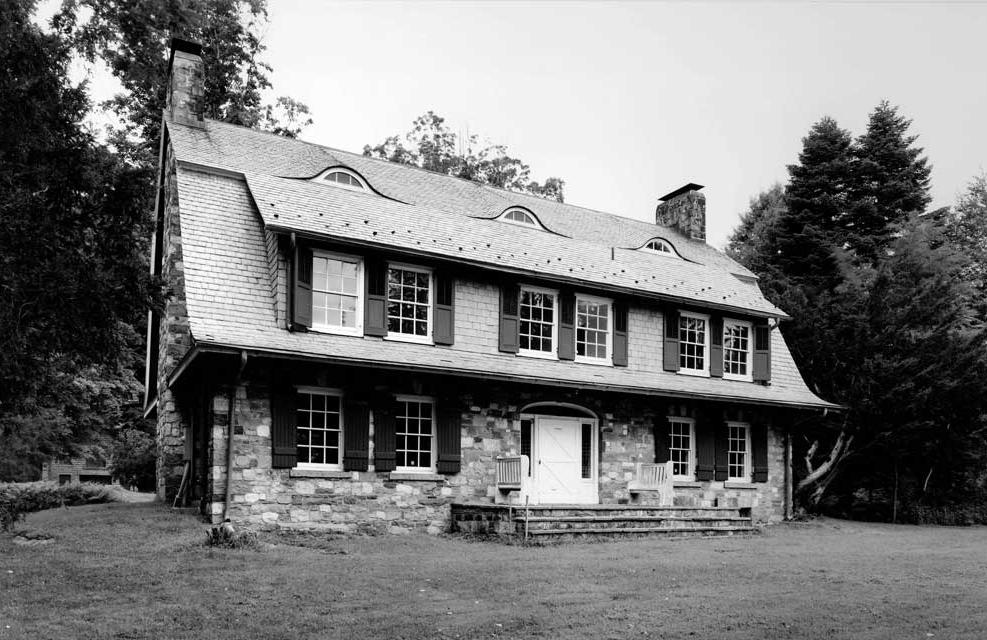 ...Click to view gallery of photos -->
...Click to view gallery of photos -->
The six high resolution black and white photgraphs here were taken in 2012 by the photographer Ray Yaros of Lebanon, NJ, and gifted gratefully to Friends of Marie Zimmermann. They are an important record of the beauty and character of Marie Zimmermann Farm (part of the Delaware Water Gap Natonal Recreation Area near Dingmans Ferry, PA), whose history as a farm goes back to the early Dutch Settlers in the 1700's.
Click here to access the website of the Delaware Water Gap National Recreation Area.
The National Park Service has more information about Marie Zimmermann. Click here for a link to a list of resources about Marie Zimmermann on National Park Service Website.


